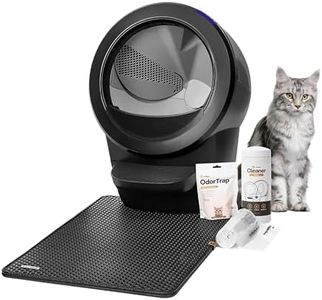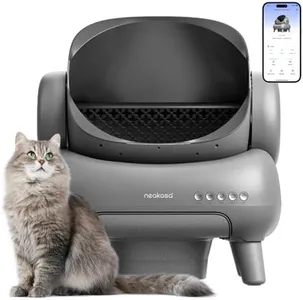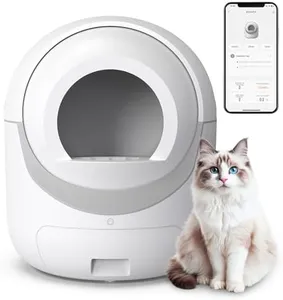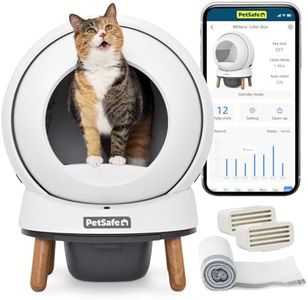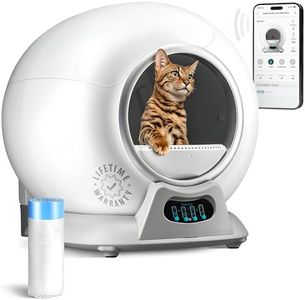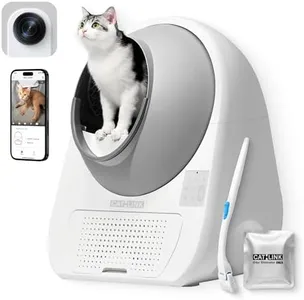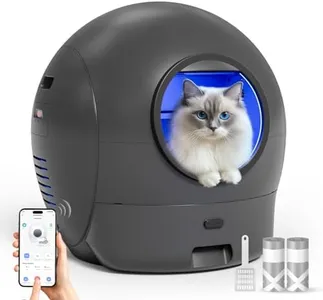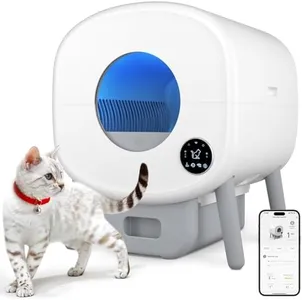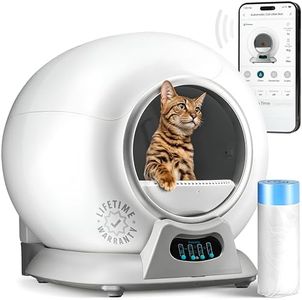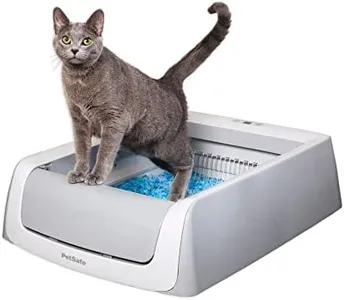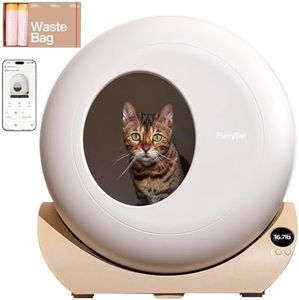10 Best Robotic Litter Box 2025 in the United States
Our technology thoroughly searches through the online shopping world, reviewing hundreds of sites. We then process and analyze this information, updating in real-time to bring you the latest top-rated products. This way, you always get the best and most current options available.

Our Top Picks
Winner
Litter-Robot 4 Core Bundle by Whisker, Black - Automatic, Self-Cleaning Cat Litter Box, Includes Litter-Robot 4, 6 OdorTrap Refills, 25 Liners, 30 Cleaner Wipes, Mat & Fence
Most important from
480 reviews
The Litter-Robot 4 Core Bundle by Whisker is a robust self-cleaning litter box designed to make cat care easier for pet owners. One of its key strengths is the automatic cleaning mechanism, which sifts through litter to separate waste, significantly reducing the need for manual scooping. This feature is especially beneficial for busy cat owners or those who may have difficulty with traditional litter boxes. The bundled extras, like the LitterTrap Mat and OdorTrap refills, further enhance its odor control capabilities, making it less odorous compared to standard boxes.
The Litter-Robot is suitable for multiple cats, accommodating up to four, provided each cat weighs at least 3 pounds. Its smart features allow pet parents to monitor litter levels and track their cats’ usage through a mobile app, adding convenience to pet management. The design is user-friendly, with easy-to-empty waste drawers and compatibility with any clumping litter.
There are a few considerations to keep in mind. The price point is on the higher side compared to traditional litter boxes, which might not suit every budget. Additionally, the unit's size (24 x 24 x 34 inches) may occupy more space than some households can comfortably accommodate. While it operates quietly, some users may still find the noise during the cleaning cycle a bit noticeable, especially for nervous pets. The safety features, including weight scale technology, require the unit to be placed on a firm surface for accurate readings, which could be a limitation in certain living arrangements. Despite these drawbacks, the Litter-Robot 4 is a strong contender in the robotic litter box market, particularly for cat owners looking for a hassle-free and efficient way to manage litter and keep odors at bay.
Most important from
480 reviews
Neakasa M1 Open-Top Self Cleaning Cat Litter Box, Automatic Cat Litter Box with APP Control, Odor-Free Waste Disposal Includes Trash Bags
Most important from
1897 reviews
The Neakasa M1 Open-Top Self Cleaning Cat Litter Box is designed for pet owners looking for convenience and cleanliness in managing their cat's litter needs. Its spacious open-top design allows for easy access, which cats tend to prefer, making it a comfortable option for felines of all sizes. This feature, along with its large waste and litter capacity, means you can manage your cat's litter for up to 14 days without needing to clean it, making it perfect for busy lifestyles or short trips.
One of its standout features is the self-cleaning mechanism, using a 'Pull and Wrap' system that effectively seals waste in odor-blocking bags, simplifying the cleaning process and keeping your home smelling fresh. The included sensors also enhance safety by pausing operation if a cat is detected inside, which is a crucial feature for cat owners concerned about their pet's safety.
The M1's open-top design, while beneficial for access, may not be the best choice for households with particularly messy or active cats, as some litter tracking could occur outside the box. Additionally, while the smart features, including app control for monitoring and litter levels, offer good connectivity, they may not be necessary for every user, potentially complicating use for those looking for a straightforward solution.
Most important from
1897 reviews
Self Cleaning Cat Litter Box, Automatic Cat Litter Box with APP Control Odor Removal Safety Protection for Multiple Cats, with Garbage Bags
Most important from
1702 reviews
The BCHARYA Self-Cleaning Cat Litter Box offers a convenient solution for cat owners who want to maintain a clean and odor-free environment with minimal effort. Its advanced self-cleaning mechanism and integrated odor control system make it a strong contender in the robotic-litter-box category. The unit is designed to operate quietly, which is ideal for maintaining a serene home atmosphere.
This is especially useful for multiple-cat households, as it helps ensure that the litter box remains clean and hygienic for all feline users. The safety features, including sensors and a delay mechanism, provide peace of mind by preventing the cleaning cycle from starting while a cat is inside the box. The eco-friendly design, which reduces litter waste, is an added bonus, making it both cost-effective and environmentally conscious.
However, there are a few potential drawbacks. The product is quite large and heavy, which might be a challenge for those with limited space or difficulty handling heavier items. Additionally, the absence of a lid might be a concern for those who prefer a more enclosed litter box to contain odors and litter scatter. Despite these points, the BCHARYA Self-Cleaning Cat Litter Box is easy to set up and maintain, with removable components that simplify cleaning. It also includes smart features that allow for convenient app control. This product is particularly well-suited for cat owners looking for a hassle-free, efficient, and eco-friendly litter box solution.
Most important from
1702 reviews
Buying Guide for the Best Robotic Litter Box
Choosing the right robotic litter box for your cat can make a significant difference in maintaining a clean and odor-free home while ensuring your pet's comfort. When selecting a robotic litter box, it's essential to consider various features and specifications to find the best fit for your needs and your cat's preferences. Here are some key specifications to look at and how to navigate them.FAQ
Most Popular Categories Right Now


